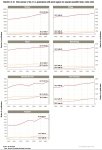 The European Commission’s Directorate-General for Research has just published an informative and data-laden report titled Science, Technology and Competitiveness Key Figures Report 2008/2009. As the press release notes, the main findings are:
The European Commission’s Directorate-General for Research has just published an informative and data-laden report titled Science, Technology and Competitiveness Key Figures Report 2008/2009. As the press release notes, the main findings are:
1. Research is a key competitive asset in a globalised world.
Major S&T players have emerged, notably in Asia. Knowledge is more and more evenly distributed with the EU now accounting for a share of less than 25%. The ERA must become more attractive, open and competitive on the global scene.
2. The overall EU R&D intensity is stagnating but this hides diversity at the national level.
All EU Member States have increased their expenditure in R&D from 2000 to 2006, which shows their commitment to the Lisbon strategy. However, GDP experienced the same rate of growth over the period, which meant that R&D intensity stayed at around 1.84% since 2005. Between 2000 and 2006, 17 Member States, mainly those which are catching up, have increased their R&D intensity, but 10, representing 47% of EU GDP, have seen their R&D intensities decrease. Japan has increased its R&D intensity from 3.04% to 3.39%, Korea from 2.39% to 3.23% and China is catching up fast, going from 0.90% to 1.42%.
3. Private Sector Investment intensity still too low.
The main reason for the R&D intensity gap between the EU and its competitors is the difference in business sector R&D financing, which decreased in the EU from 2000 to 2005 while it increased substantially in the US, Japan and China. This is mostly due to the smaller size of the research-intensive high-tech industry in the EU. Building the knowledge intensive economy requires structural changes towards higher R&D intensities within sectors and a greater share of high-tech sectors in the EU economy. This requires framework conditions that favour the development of fast-growing high-tech SMEs, the development of innovation-friendly markets in Europe and cheaper access to EU-wide patenting.
4. Excellence in research: a growing pool of researchers a still lower capacity of knowledge exploitation than competitors.
The number of researchers has grown twice as fast in the EU as in the US and Japan since 2000, even if the share of researchers in the labour force is still lower. As regards impact of research, the EU still ranks as the world’s largest producer of scientific knowledge (measured by publications), but contributes less than the US to high impact publications.
5. An increased attractiveness to foreign investments and S&T professionals.
The EU has been attracting a growing share of private R&D investments from the US despite the rise of Asia as a new R&D location. In 2005, US affiliates made 62.5% of their R&D investments in the EU and only 3.3% in China. It has also been attracting a growing number of S&T professionals from third countries.
This 169 page report is a multi-scalar mapping of sorts; a distillation of the agendas and impacts associated with efforts to (a) integrate the European Research Area (ERA), while also (b) deepening collaborative relations with select geographies of the global research landscape. As some sample figures from the ‘international’ section of the report indicate, this is indeed a very uneven global research landscape on a number of axes, yet a fast changing one too.
Science, Technology and Competitiveness Key Figures Report 2008/2009 should be read in association with Europe’s new (2008) Strategic Framework for International Science and Technology Cooperation, as well as the very important Council ‘Conclusions concerning a European partnership for international scientific and technological cooperation‘ (2 December 2008).
In addition, please recall our 4 August 2008 entry (‘Globalizing research: forces, patterns, and collaborative practices‘), which also refers to some related research reports.
We’ll be returning to the topic of the global dimensions of the ERA over the next few months, and we’re also planning a series of entries related to regionalism, interregionalism, and the complex relationship between higher education and research.
Kris Olds


